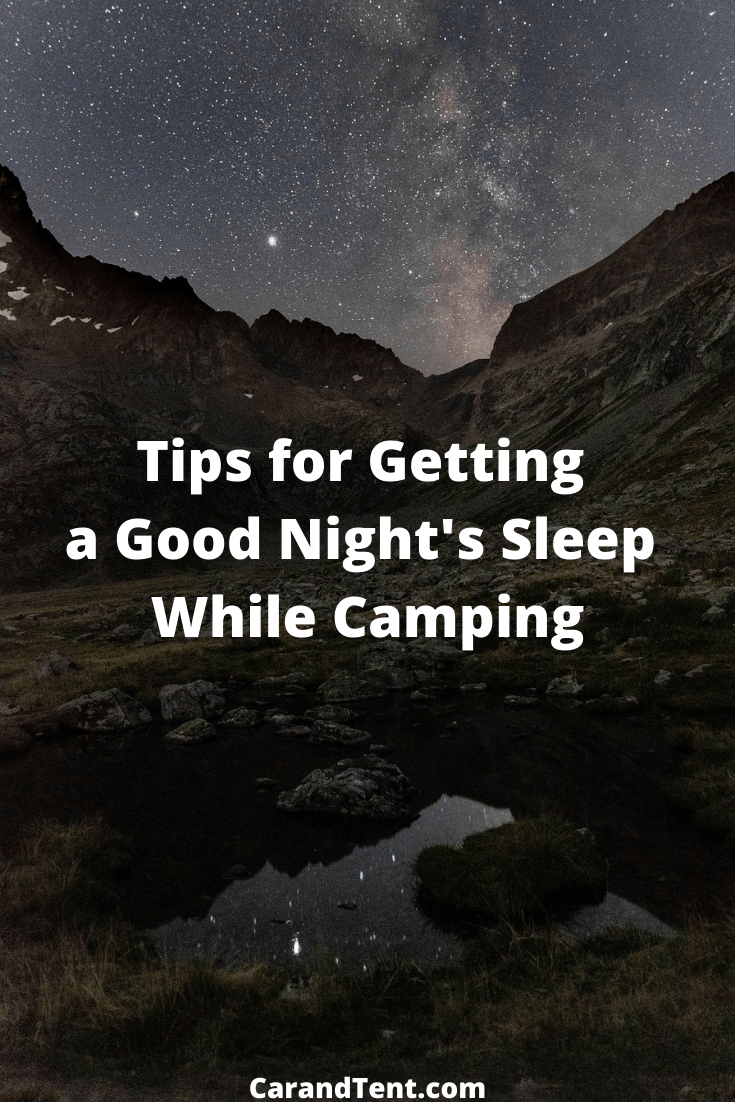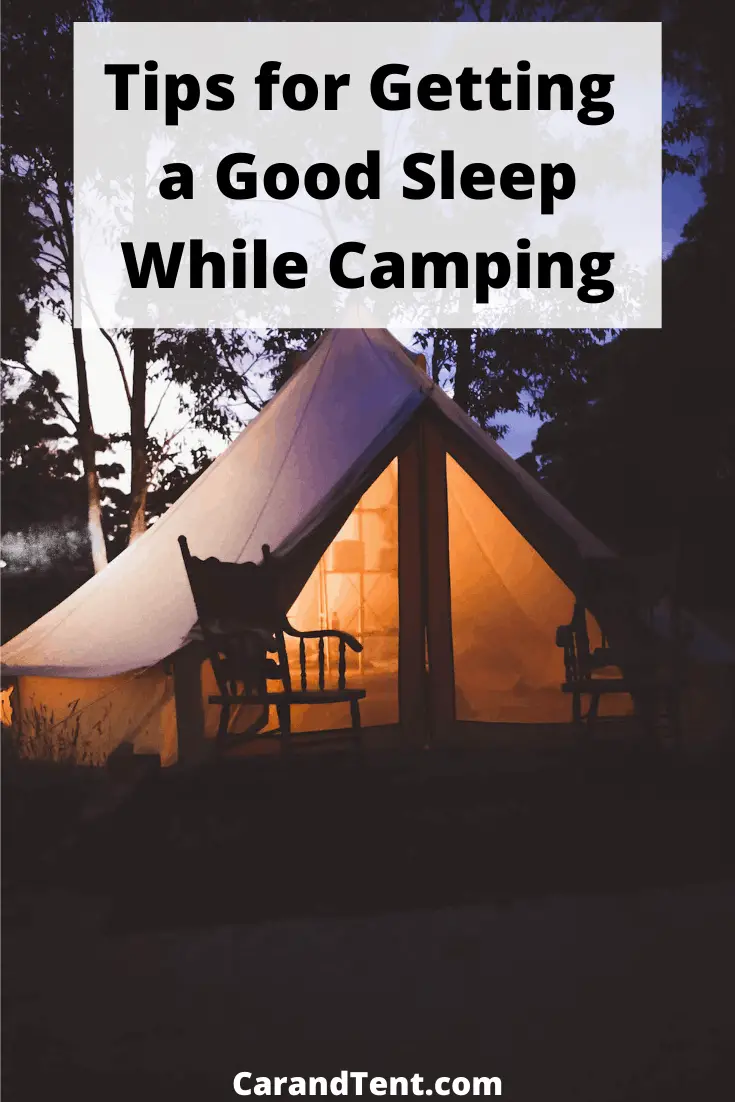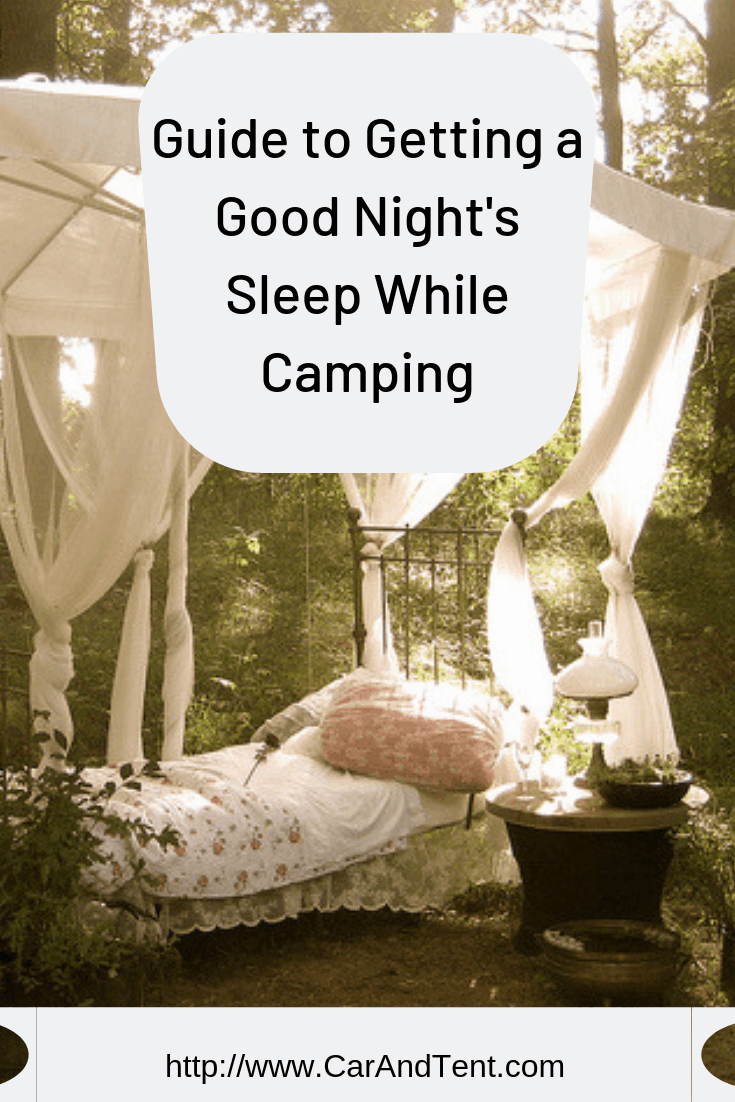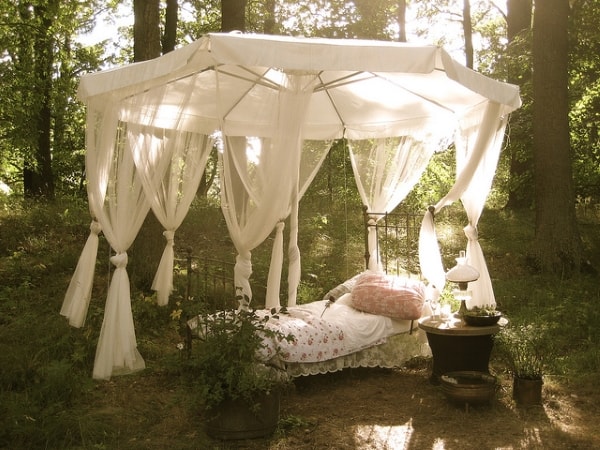
Getting a bad night’s sleep can quickly ruin an otherwise great camping trip. Often-times, the key to getting a night of good sleep when camping is bringing the right things and doing the right things when camping.
In this post, I’ll give you some helpful tips to help you get a good night’s sleep when camping. I’ll also go over sleeping bags, sleeping pads, cots, and even mattresses used for camping so that you’ll know what to bring and when to bring it.
Table of Contents
Why Sleep Matters and What Could Ruin Yours
Just one night of poor sleep can lead to irritability, memory problems, depression, a loss of focus, anxiety, and a whole host of other issues. This information makes it easy to see why sleep is important. It also makes it easy to see why people worry about getting a good night’s sleep while camping. After all, how can you have an enjoyable camping experience if you’re anxious, irritable, and depressed?
There are many factors that can cause you to lose sleep while camping. These factors can include too much noise, poor temperature regulation, and a lack of physical comfort.
Another factor that new campers often worry about is safety. People are used to sleeping in houses with hard walls and solid doors and the thought of sleeping with only some nylon between them and the outside world is a bit disconcerting to them.
Luckily all of these factors can be overcome and in the next few sections, we’ll go over how to eliminate or at least manage the factors that can cause bad sleep.
Reducing Noise Inside Your Tent
The best way to reduce noise is to camp someplace quiet. State parks are best for this as they usually have quiet hours and a prohibition on alcohol. Most parks will even place restrictions on the use of generators so you won’t have to worry about going to sleep next to your neighbor’s loud generator.
If you can’t find a quiet campsite, change the sound you’re hearing by bringing a device that creates white noise. A simple fan might be all you need to drown out the sounds coming into your tent. If you can’t run a fan, consider putting a white noise application on your smartphone. This way you can fall asleep to the sounds of rain or waves crashing on a beach.
For those of you who don’t like white noise and prefer silence, get a good pair of earplugs. Earplugs will block out any loud noises like generators and barking dogs.
Reducing Your Fear of Sleeping in a Tent
If you’re camping in the United States, you really don’t have too many wild animals to worry about while sleeping. In fact, there are only three animals that you should really concern yourself with. These are bears, mountain lions, and humans. Theoretically, an alligator or crocodile could attack you inside your tent as well but I’ve never heard of such an incident. This being said, I have read of a person being pulled from a tent by a crocodile in Australia.
The Fear of Getting Eaten by a Bear While Camping
Here are some facts to put your mind at ease.
According to the Journal of Wildlife Management, black bears have killed at least 63 people in the United States and Canada combined….over a period of 109 years.
Most of these attacks were in Canada and Alaska and most of these people were not sleeping in a tent when these attacks occurred. In fact, it can be speculated that the cause of many of these attacks was people accidentally surprising and scaring the black bears that attacked them.
The American black bear is the most common bear in the United States and you’re unlikely to run into a grizzly bear or a polar bear outside of Alaska. Wyoming, Montana, Idaho, and Washington may also give you an opportunity to run into grizzly bears but your chances are still quite low.
As you can see, your risk of getting killed by a bear inside your tent is extremely low. To reduce your chances even further, practice proper food safety rules and read about bears on my page titled, “Camping with Bears – How to Stay Safe“.
Fatal Attacks by Mountain Lions in the United States
The mountain lion, which you may know as the puma or panther has only killed 27 people over the last 100 years. To put it into perspective, more than ten times that number have been fatally attacked by dogs.
Also, unless you’re camping in one of the 16 states that have large mountain lion populations, you’ll probably never even encounter a mountain lion.
Camping and Hiking with Mountain Lions – What are your chances?
To avoid mountain lion attacks while camping, go in a large group and keep small children and animals close by. Mountain lions are extremely unlikely to attack a full-grown adult and they rarely ever attack a group of people. I believe the official reason for this is that they are “scaredy cats”.
People Attacking Sleeping Campers
While it is possible that someone could attack you while you’re camping, it is extremely unlikely. The FBI reports about 5 murders per every 100,000 people and most of these murders occur on city streets.
If you’re really concerned about this, camp at a modern campsite in a state, national, or private park. There you’ll have rangers or guards patrolling the area which means you’ll probably be safer there than you were at home.
Getting Comfortable
Now that you feel safe, let’s talk about getting comfortable.
In the next few sections we’ll talk about:
- Sleeping Bags
- Sleeping Pads
- Camping Cots
- Camp Beds
You don’t have to bring along all of these items but you should at least consider them. The more bedding you bring, the more comfortable you’ll be. If anyone complains, just tell them you’re not camping, you’re glamping.
Sleeping Bags
Your sleeping bag can greatly affect the quality of sleep you get while camping. A sleeping bag that is too warm will leave you sweaty and uncomfortable while a sleeping bag that is not warm enough will leave you cold and miserable.
Choose a sleeping bag that is rated for your climate. Add clothing for extra warmth and unzip the bag when you feel you’re too hot.
For more detailed information on choosing a sleeping bag, read my post titled, “How to Choose a Sleeping Bag – Everything You’ll Ever Need to Know“. On this page, you’ll discover information on temperature ratings, material selection, and much more.
Sleeping Pads for Camping
Sleeping pads are essential for backpackers and canoe campers and can even be used when car camping. Even the military issues sleeping pads to its soldiers for trips out into the field.
A sleeping pad can be as simple as a mat that rolls up to as advanced as a self-inflating mat that rolls up tightly to fit into a backpack and expands to provide more comfort when unrolled.
When you choose a sleeping pad, you’ll want to consider size, weight, comfort, and insulation. Insulation is measured by the sleeping pads r-value. The higher the R-value, the more insulation the padding provides.
Car campers can choose a larger and heavier sleeping pad while backpackers and canoe campers will need to choose something that is easier to both pack and carry into the wilderness.
Some materials to choose from are memory foam, rubber, and even plastic. Closed-cell foam pads are the heaviest and bulkiest while the rubber and plastic pads are the lightest and pack down the smallest.
Types of sleeping pads:
- Closed-cell foam pads.
- Self-inflating pads.
- Inflatable pads.
Closed Cell Foam Sleeping Pads
Closed-cell foam pads provide the most comfort out of the three types of sleeping pads. These pads are also the most durable as they do not have any air pumped into them and therefore do not have to be concerned with punctures. I was issued this type of pad when I was in the Army and it worked quite well.
The drawback to this type of pad is that it is heavier than the other types of pads and it is not easy to pack. In fact, most backpackers will need to strap these types of pads to the outside of their backpacks.
Self-inflating Sleeping Pads
Self-inflating pads are the second most comfortable types of sleeping pads used for camping. They combine foam padding with pockets of air that naturally fill themselves up when you unroll the sleeping pad. When you roll the pad back up it forces the air out so you end up with a more compressed sleeping pad than you have with a standard closed-cell foam sleeping pad.
The drawback to this sleeping pad is that it isn’t as durable as a closed-cell foam sleeping pad. Also, it isn’t as light or packable as an inflatable sleeping pad. Basically, this type of sleeping pad gives you some of the benefits of the other two types of sleeping pads while also giving you some of the disadvantages of each of the other two types of sleeping pads.
Inflatable Sleeping Pads
Inflatable sleeping pads can compress down small and they are lightweight. This makes them great for backpacking and canoe camping.
The drawback to this type of sleeping pad is that it can easily be punctured. This means you’ll have to bring a patch kit and you’ll have to know how to use it.
Also, these sleeping pads do need to be inflated. In most cases, you’ll just use your lungs for this and in other cases, the pad will have a built-in method for inflating it.
Sleeping Pad Examples
The Therm-a-Rest RidgeRest Classic Foam Camping Sleeping Pad – This sleeping pad is a memory foam sleeping pad that comes in two different sizes. It rolls up tightly enough to be used on a backpacking trip while providing durability and comfort. It has an R-value of 2.6
If you’re looking for a durable and versatile sleeping pad to take camping, you might want to look into the RidgeRest Classic.
Western Owl Outfitters Self-Inflating Sleeping Pad – This sleeping pad combines foam padding with air to create a self-inflating sleeping pad with a lot of insulation. The R-value on this sleeping pad is 4.9 which makes it a great winter camping sleeping pad.
Because of the air pockets, you end up with a pad that is over 2 inches thick when unrolled but only 8″ x 10″ when rolled up. This sleeping pad is great for car camping and for backpackers who don’t mind carrying a thicker sleeping pad in their backpack.
The Wellax Ultralight Air Sleeping Pad – The Wellax Ultralight Air Sleeping Pad rolls up to a size of just 10″ x 3.5″. It also weighs less than a pound, which makes it a great backpacking sleeping pad.
This pad is designed so that it can easily be inflated in under 7 breaths. It also has an R-value of 2.1 which is great considering how small it rolls up. If you’re looking for a 3-season camping sleeping pad, you might want to consider this one.
Camping Cots
Camping cots are great for camping because they physically elevate you off of the ground. This helps to eliminate any condensation you may have gotten from the ground and stops you from getting wet even if your tent ends up flooding.
I also like the fact that you can use camping cots as a bench to sit on and a place to store gear underneath. Also, people with camping cots aren’t restricted to using the cot alone. If you have a sleeping pad you can always place that on top of the camping cot for maximum comfort and insulation.
When buying a camping cot, you’ll want to consider size, weight, quality, and comfort. You may also want to consider accessories like storage compartments and built-in pads and pillows.
Personally, I stay away from using camping cots for backpacking but it is possible to find smaller and lighter cots that you could theoretically take backpacking with you. These types of camping cots are usually around 10 pounds and they use plastic legs that fold into themselves.
This type of folding design packs down into the shape of a traditional sleeping pad rather than the shape of a briefcase like some of the older camping cots.
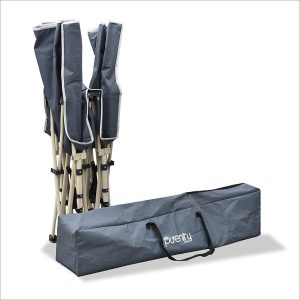
While this type of cot does fold down smaller, it is still quite bulky and best left for car camping and canoe camping.
You can buy cots in all different bed sizes and some car campers will buy camping cots built for two people. These cots can also come in bunk bed styles so you can maximize your tent’s space by buying a bunk bed camping cot to use inside your tent.
Examples of Camping Cots
The Alpcour Folding Camping Cot – This cot measures 74.8″ long and 26.8″ wide. If you can comfortably sleep on a normal-sized couch, you can comfortably sleep on this. The Alpcour folds into itself and weighs in at about 13 pounds so you can take it on short backpacking trips or on canoe camping trips.
A nice feature of this camping cot is that it comes with a built-in pillow, an elevated headrest, and side pockets.
The Coleman ComfortSmart Cot – This camping cot is 80″ long and 30″ wide. For comparison, a standard twin-sized bed is 75″ long and 39″ wide. The extra length of this cot means that even taller people can get a comfortable night’s sleep.
A foam mattress covers the steel frame of this cot so you get more padding than you would with a traditional cot.
The Desert Walker Ultralight Camping Cot – The Desert Walker Ultralight Camping Cot is the only one of these three cots that could seriously be considered as a backpacking cot. This cot weighs in at less than three pounds and folds up into a 19.6″ x 4″ package.
It achieves its small size by getting rid of most of the framework and elevated the cot only a few inches from the ground. This keeps you off the ground but does not provide the feel of a bed like the other two cots do. If you’re looking for a true backpacking cot or a cot to fit in a tent with a low ceiling, this might be the cot you’re looking for.
Camping Mattresses
A camping mattress is typically just an air mattress or a thick memory foam pad. These would only be used for car camping as they take up a lot of space and take some extra power to inflate.
If you’ve ever slept on an air mattress at home, you know what an air mattress feels like. The only difference will be that you will have to watch out where you set the mattress up as you are more likely to puncture your air mattress outdoors than you are in your living room.
Personally, I do not like air mattresses for camping or for the house. A self-inflating pad can provide almost as much comfort as an air mattress and it is more durable. This being said, if you already have an air mattress that you like to sleep on, it can’t hurt to take it with you on your next big car camping trip. Just be careful not to set it up on sharp rocks or sticks.
How to Make a Wilderness Camping Mattress
If you found yourself out in the wilderness without a sleeping pad, you can always make one for yourself. There are a few ways to do this so it will depend on what you have available to you.
For those of you in the forest, consider hunting for branches from pine trees. Pine branches can be stacked up on top of each other to make a soft bed. Just be careful doing this in the warmer months as they could be filled with ticks or other bugs you don’t want crawling on you.
Another natural bedding material is moss. Moss is nice and soft and can easily be scooped up out of the ground to provide you with a nice natural mat. When you’re done camping, you can always put the moss back down where you found it.
If you’re in an area where you need to practice no-trace principles, you might want to consider digging your own bedding. Side sleepers can dig a small indent for their hips to comfortably sleep in while back sleepers can dig out a small crevice for their hips to sit in while they sleep. These methods are especially useful for people camping in the desert or on the beach where it might not be possible to find moss or pine branches.
For those of you who can’t do any of the above methods, consider creating a layer of padding with your clothing. This will not only pad you from the ground but it will also add a small layer of insulation. Just make sure you place a tarp down under your clothing so that it does not end up getting wet from condensation.
Set Your Camp Up in The Right Spot
Even with the proper tent and proper bedding, you might still find it hard to sleep when you’re at camp. One reason why could be that you set your campsite up at the wrong spot.
Areas with high winds will be loud and your tent may blow around all night. Conversely, areas without enough wind might be full of flying insects and you might end up with mosquitos buzzing around your ears all night.
Pitching a tent over the top of rocks, sticks, or pine cones can also hinder your ability to get comfortable. Some people believe that a good sleeping pad can make up for not clearing a tent site but unfortunately, this simply isn’t true. Most camping pads are not thick enough to lay flat over rocks or pinecones, so make sure you clear your campsite before you pitch your tent.
Another thought to keep in mind is your proximity to the bathrooms. While some people like to camp close to the bathrooms in case they need them, I personally hate being near them. Oftentimes, campground bathrooms stink.
Having to smell a dirty bathroom all night is a surefire way for me to have trouble falling asleep. Not only this, but you’ll have people walking by your campsite with flashlights all night long headed to the bathroom.
Prepare for Bed
I don’t know about you but I have a definite bedtime routine at home. When I fail to adhere to this routine and fall asleep on the couch watching television, I end up having a poor night’s sleep.
Unfortunately, camping can mess up your typical bedtime routine and you have to be proactive about keeping it. Try to keep your normal routine as best as possible and if this fails, try to establish a new routine that you use for camping.
The ritual of brushing your teeth right before bed or writing in your journal does more than clean your teeth and collect your thoughts. After you’ve been going to sleep right after brushing your teeth or writing in your journal for a period of time, you begin to associate the activity with sleep and you naturally become tired right after doing it.
If you’re a pre-bedtime journal writer, bring along your journal. If you always brush your teeth right before bed, do the same thing when you’re out camping. Your normal bedtime ritual will help you fall asleep quicker and easier even when you’re camping in the woods.
Don’t Eat Too Much
The food you eat while camping will probably be some of the tastiest food you’ve ever eaten. However, this doesn’t mean you need to eat it all night long. WebMd.com recommends that you stop eating at least 2 to 3 hours before you go to bed. This will reduce acid reflux and will help you have a better night’s sleep.
If you find you’re too hungry to go to sleep, eat something light and bland so that you do not upset your stomach. Also, drink just enough water with it to keep you from getting thirsty, and be sure to head to the bathroom before you go to bed. Getting up in the middle of the night to use the restroom while camping is a hassle, even if you have your own portable toilet with you.
Don’t Sleep In Too Long
While it can be tempting to sleep in while on vacation, it isn’t a good idea. Sleeping too long can have adverse effects on your health and it can definitely destroy your sleeping patterns.
In fact, John Hopkins found that oversleeping can lead to type 2 diabetes, heart disease, obesity, depression, headaches, and a greater risk of dying from a medical condition. Even if you don’t suffer from any of these issues, I’m sure we can all agree that we feel groggy in the morning after we’ve slept too long.
Not only this but sleeping in increases the chances that we won’t be tired as early as we normally are. This ends up leading us to stay up late which in turn leads us to sleep late again the next day. The vicious cycle continues on and on until the camping trip is over and it’s time to go back to work.
Final Thoughts
In today’s world, sleep can be hard to come by. Your camping trip might be the best opportunity you have to catch up on it. Make sure you’re physically and mentally comfortable and you could end up having the best sleep of your life on your next camping trip.

